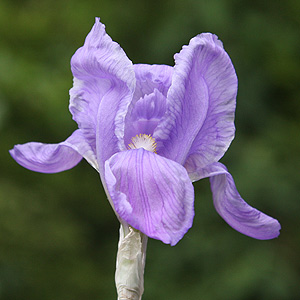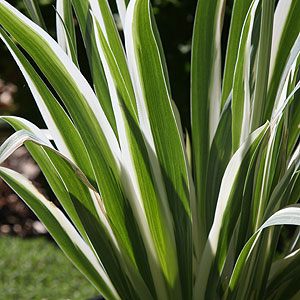With standout variegated foliage as well as attractive flowers, Iris Pallida variegata is a garden worthy plant. It has a little history on its side as well. It is one of the species that has given rise to the many bearded Iris that we see today.

Commonly refered to as the Dalmation Iris, this hints at its origins in the lower alpine regions of Croatia. Also known as the ‘Sweet iris’ as it is delictly perfumed. You will also find it listed in older refeences as ‘Argentea Variegata’, argentea means silvery, and the variagetion does give a silver look.
This is a rhizomatous perrenial, strongly erect foliage, sword shaped and with typical iris flowers. The foliage in itself is striking, boldly white to cream and pale green striped. The foliage actually changes color a little, new it it is a pale yellow, bur fading to white before the the flowers appear.
The flowers buds are a deep indigo blue opening to a paler lavender blue, and although it is a plant that can reach nearly 3ft in height it is often shorter than this. Flowering time is late spring to early summer, this make it a plant that can extend the season.
For us this is a very hardy disease free plant, however, like all Iris it can suffer a few problems, including slugs, snails and leaf scorch in hot summers. The main issue is poor drainage which can cause rhizome rot.
Care

Best is a position where it receives good morning sun and light shade in the afternoon. Rhizomes needs to be planted near the surface with a little above the soil level. Foliage should be cut back to allow the plant to settle in and reduce movement of newly planted rhizomes until root system is established. Water in with a liquid seaweed fertilizer.
Like all rhizomatous iris, a well drained soil is essential. This is another of those plants that likes to be left alone. Often failing to flower the first year, and then sulking after being transplanted or divided.
In warmer climates some supplementary water in summer may be required. This is a species that will flower in part shade especially in warmer climates.
Prune away dead and damaged foliage in fall. Spent flower heds can be removed, or left to set seed if you wish.
Regarded as hardy in USDA zones 4 – 9.
Propagation
The easiest form of propagation is by division, best time for this is mid summer.
Remember that Iris Pallida variegata may decide not to flower the year after being divided.
You could grow from seeds sown into a cold frame in late summer to fall, immediatly after you have collected them.
However in our experience this is an iris that will multiply fairly well in the garden, and propagation from seed to flowering size is slow.
Summary
- Botanical Name : Iris Pallida variegata
- Height : 3ft
- Growth : Rate Slow from seed, moderate once established
- Flower color : Blue buds opening to lavender blue
- Foliage : Strong variegation Green and creamy white to yellow
- Flowering period : Spring to summer, later in cooler areas
- Seasonal interest : Spring to Summer for foliage
- Landscaping uses : Garden borders, containers and general uses
- Soil Requirements : Well drained, netral to slightly acidic ph
- Position : Full sun to light afternoon shade
You may also like
- Bearded Iris
- Dutch Iris
- Pacific Coast Iris
- Japanese Iris
- Louisiana Iris
- Iris Katharine Hodgkin
- Iris Pallida variegata
Iris Pallida variegata is available for sale from the following growers –
WHITE FLOWER FARM phone 1-800-503-9624
STOUT GARDENS – 405-642-4190
432 NE 70th St
Oaklahoma City, OK 73105
SCHRIENER’S IRIS GARDENS phone 800-525-2367
3625 Quanaby Road N.E
Salem OR, 97303 USA

